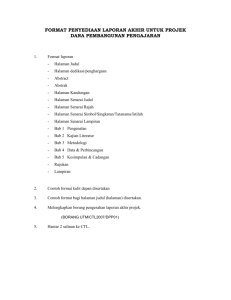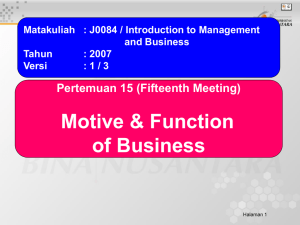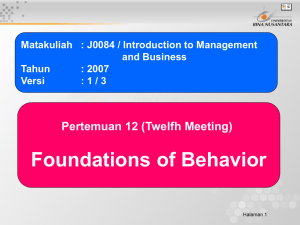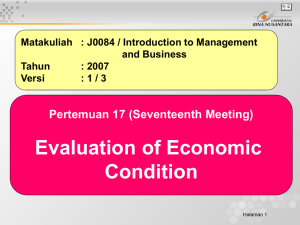Planning Tools and Techniques Pertemuan 06 (Sixth Meting)
advertisement
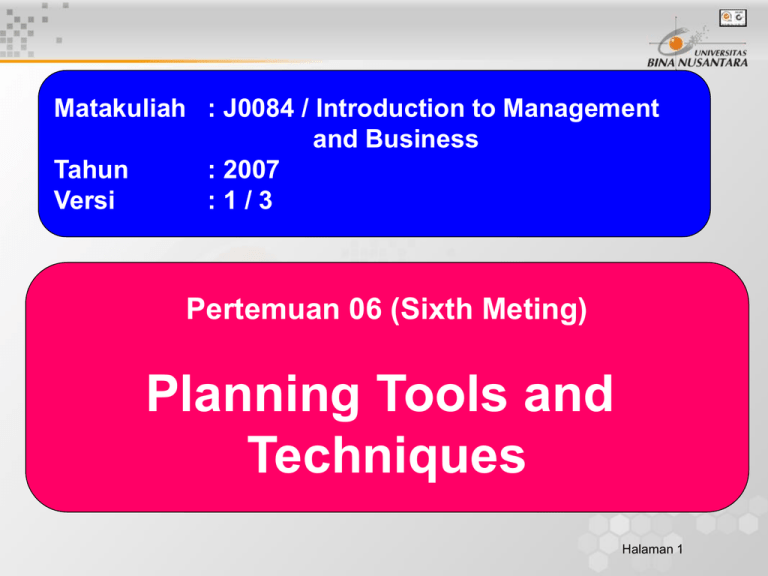
Matakuliah : J0084 / Introduction to Management and Business Tahun : 2007 Versi :1/3 Pertemuan 06 (Sixth Meting) Planning Tools and Techniques Halaman 1 Learning Outcome Student should be able to show the use of planning tools and techniques which are needed by the organization -> C3 Halaman 2 Learning Outline • Techniques for Assessing the Environment • Techniques for Allocating Resources • Contemporary Planning Techniques Halaman 3 1. Techniques for Assessing the Environment a. Environmental Scanning It’s the screening of large amounts of information to anticipate and interpret changes in the environment 1) Competitor Intelligence It’s a process by which organization gather information about their competitors. Who are they? What are they doing? How will what they’re doing affect us? 2) Global Scanning Halaman 4 b. Forecasting 1) Forecasting Techniques a) Quantitative forecasting applies a set of mathematical rules to a series of past data to predict outcomes b) Qualitative forecasting, in contrast, uses the judgment and opinions of knowledgeable individuals to predict outcomes Halaman 5 2) Forecasting Effectiveness a) Forecasting techniques are most accurate when the environment is not rapidly changing b) Use simple forecasting methods c) Use rolling forecasts that look 12 to 18 months ahead, instead of using a single, static forecast d) Don’t assume that you can accurately identify turning points in a trend e) Remember that forecasting is a managerial skill and as such can be practiced and improved Halaman 6 c. Benchmarking Benchmarking is the search for the best practices among competitors or non competitors that lead to their superior performance Steps in Bench marking Prepare and implement action plan Identify: What is to be benchmarked Form a Comparative organizations benchmarking Data Collection methods planning team Best practices Analyze data to identify performance gaps Gather internal and external data Halaman 7 2. Techniques for Allocating Resources a. Budgeting Cash Budget Forecasts cash on hand and how much will be needed Revenue Budget Project future sales Variable Budget Takes into account the cost that vary with volume OR Expense Budget Lists primary activities and allocates dollar amount to each Fixed Budget Assumes fixed level of sales production Profit Budget Combines revenue and expense budget of various units to determine each unit’s profit contribution Halaman 8 b. Scheduling 1) Gantt Charts Activity 1 2 Month 3 4 Copyedit manuscript Design sample pages Draw artwork Print first pages Print final pages Design cover Actual progress Goals Reporting Date Halaman 9 2) Load Charts Editors Month 1 2 3 4 5 6 Annie Antonio Kim Maurice Dave Penny Work scheduled Halaman 10 3) PERT Network Analysis a) Event b) Activities c) Slack time d) Critical path Halaman 11 Event Description Expected time (week) Preceding event A Approve design and get permit 10 None B Dig subterranean 6 A C Erect frame and siding 14 B D Construct floor 6 C E Install windows 3 C F Put on roof 3 C G Install internal wiring 5 D, E, F H Install elevator 5 G I Put in floor covering and paneling 4 D J Put in doors and interior decorate trim 3 I, H K Turn over to building management group 1 J Halaman 12 A PERT Network for constructing an office building 4 D 6 10 Start 14 6 A B 3 C I 5 5 5 G E 1 J H K 3 3 5 F Calculation the length of time that each path of activities will take: A-B-C-D-I-J-K (44 weeks) A-B-C-D-G-H-J-K (50 weeks) A-B-C-E-G-H-J-K (47 weeks) A-B-C-F-G-H-J-K (47 weeks) Halaman 13 c. Break Even Analysis TFC BE = P - VC Note: BE P TFC VC = Break Even Point = Price = Total Fixed Cost = Variable Cost Halaman 14 Break even analysis Total Revenue Revenue/Cost ($) 70.000 Profit Area 60.000 50.000 40.000 Los s Area Variable Costs Break Even Point 30.000 Total Cost s Fixed Costs 20.000 10.000 100 200 300 400 500 600 Output (in thousands) Halaman 15 d. Linear programming Production Data for Cinnamon-Scented Products Numbers of Hours Required (per unit) Potpourri Scented Monthly Department Bags Candles Production Capacity (in hours) Manufacturing 2 4 1,200 Assembly Profit per unit 2 $ 10 2 $ 18 900 2P + 4S < 1,200 2P + 2S < 900 Halaman 16 Quantity of Scented Candles Graphical Solution to Linear Programming Problem 700 600 500 F 400 300 B 200 Feasibility Region 100 C A 100 200 300 D 400 500 E 600 Quantity of Potpourri Bags Halaman 17 3. Contemporary Planning Techniques a. Project Management Project Planning Process Define Objectives Determine Project completion date Identify Activities and resources Establish sequences Compare with objectives Establish time for activities Determine additional resources requirement Halaman 18 b. Scenario Planning Preparing for Unexpected Events 1) Identify potential unexpected events 2) Determine if any of these events would have early indicators 3) Set up an information gathering system to identify early indicators 4) Have appropriate responses (plans) in place if these unexpected events occur Halaman 19
